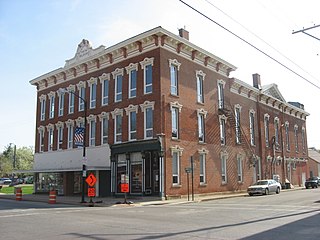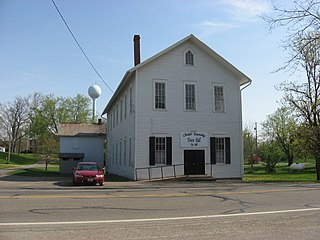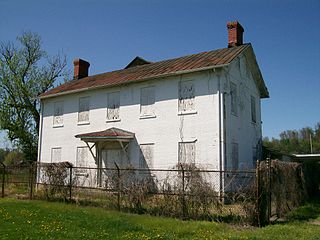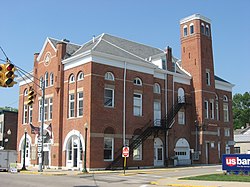
The Ohio Theatre is a historic theater in Loudonville, Ohio. It is one of many theaters in the state named "Ohio Theatre". It is at 156 North Water Street and was built on the site of the town's first theatrical building of 1874. In 1997 it was named in the National Register of Historic Places, under the name of "City Hall and Opera House".

The Thomas Select School is a historic log building in rural Butler County, Ohio, United States. Constructed in 1810, the building has seen numerous uses, ranging from church to school to house. It has been named a historic site.

The Versailles Town Hall and Wayne Township House, located at 4 West Main Street in Versailles, Ohio, in the United States, is an historic brick town hall building built between 1875 and 1876 by joint resolution of the Versailles Village Council and the Wayne Township Trustees. It is also known as the Versailles Village Hall. On February 18, 1981, it was added to the National Register of Historic Places.

The Opera House at Boothbay Harbor, also known historically as the Boothbay Harbor Opera House, Knights of Pythias Hall, The Opera House, and as the Pythian Opera House, is a historic meeting hall and multifunction building at 86 Townsend Avenue in Boothbay Harbor, Maine. Built in 1894, it has housed government offices of the town, and the meeting spaces of fraternal organizations, prior to its present use as a performance venue. It was listed on the National Register of Historic Places on December 30, 2008.

Claremont City Hall, also known as the Claremont Opera House, is located at 58 Opera House Square in the heart of Claremont, New Hampshire, United States.

Levering Hall is a historic building in downtown Mount Gilead, Ohio, United States. A fine example of the Italianate style, it was intended to house a range of civic functions.

Precious Blood Catholic Church is a Roman Catholic parish in Chickasaw, Ohio, United States. Erected in 1903 and still an active parish, the church historically owned two buildings constructed in its early years that have been designated as historic sites.

The Brown Township Building is a historic building in downtown Ansonia, Ohio, United States. Built in the Italianate style in 1883, this two-story structure has historically been the most prominent structure in Ansonia and Brown Township. From the 1880s until the 1950s, the lower floor was used as the village jail, the post office, the fire station, offices for the village and township governments, and a polling place. Although many of these functions have ceased, the governmental offices and polling place remain. Since the building's construction, the upper floor has continuously been a community center for the village and the township, serving as the location for manifold social events through the years.

The Thomaston Opera House is a historic performance venue and the town hall of Thomaston, Connecticut. Located at 153 Main Street, it was built in 1883-85, and is a good local example of Romanesque architecture. The theater in the building has served as a performance and film venue since its construction. It was listed on the National Register of Historic Places in 1972. The opera house's principal tenant is now the Landmark Community Theatre.

The Chester Town Hall is a historic governmental building and community meeting place in the village of Chesterville, Ohio, United States. Built in the 1860s by the village and a fraternal society, it has served as home for both entities throughout its history, as well as providing space for Chester Township officials and community gatherings. Along with numerous other buildings in the village, it has been named a historic site.

The Sawyer–Curtis House is a historic residence in the community of Little Hocking in Washington County, Ohio, United States. Located along the Ohio River in southern Belpre Township below the city of Belpre, Little Hocking was settled shortly before 1800. The earliest settler in the vicinity of Little Hocking was Nathaniel Sawyer, a native of Massachusetts who erected a New England–style of house there in 1798. Now known as the Sawyer–Curtis House, it is believed to have been the first permanent structure to be erected anywhere in Belpre Township. Sawyer's house is a weatherboarded structure with a tin roof and a foundation of sandstone. Built around a frame of logs, it is constructed with a typical New England floor plan, with its most significant individual feature being a massive chimney at the center of the house.

The Judge Joseph Barker House is a historic residence in southern Washington County, Ohio, United States. Located along State Route 7 southwest of the community of Newport, it is a brick structure with a roof of metal, a foundation of sandstone, and other elements of wood and metal. Constructed in 1832, it is a two-story rectangular building that sits atop an Ohio River bluff. Its floor plan is five bays wide, featuring a central entrance with a fanlight and sidelights.

The Whitelaw Reid House is a historic residence near the village of Cedarville in Greene County, Ohio, United States. Built in the early nineteenth century, it was home to a prominent American journalist, and it has been named a historic site.

The Jamestown Opera House is a historic government building and community center in the village of Jamestown, Ohio, United States. It has been named a historic site because of its well-preserved architecture. Besides serving as a theater, the opera house has functioned as the community's village hall, its fire station, its post office, and its library.

The Harper Mausoleum and George W. Harper Memorial Entrance are a pair of funerary structures in the village cemetery at Cedarville, Ohio, United States. Commemorating one of Cedarville's wealthiest nineteenth-century citizens, they have together been named a historic site because of their distinctive Egyptian-style design.

The Perry County Courthouse is a historic government building in the city of New Lexington, Ohio, United States. Built near the end of the nineteenth century after the end of a county seat war, it is the fifth courthouse to serve Perry County, and it has been named a historic site because of its imposing architecture.

The Wakefield Town Hall and Opera House is a historic municipal building at 2 High Street in the Sanbornville village of Wakefield, New Hampshire. Built in 1895, it is a prominent local example of Romanesque architecture, and has housed civic and social activities since its construction. The building was listed on the National Register of Historic Places in 2007, and the New Hampshire State Register of Historic Places in 2002.

Pawlet Town Hall houses the municipal offices of the town of Pawlet, Vermont. Located at 122 School Street in the village center, it was built in 1881 as a combined town hall, meeting and performance venue, and retail establishment. It has served as town hall since its construction, and is a good local example of late Italianate architecture. It was listed on the National Register of Historic Places in 1995.

Fairlee Town Hall, at 75 Town Common Road, is the municipal heart of Fairlee, Vermont. It was built in 1913 to a design by a local architect, replacing the old Fairlee Opera House, which was destroyed by fire in 1912. It is a fine example of Colonial Revival architecture, and is a focal point of the village center and the town's civic life. It was listed on the National Register of Historic Places in 2014.

The Litchfield Opera House is a community building in Litchfield, Minnesota, United States, listed on the National Register of Historic Places for its significance to the community. A committee of businessmen organized in 1899 with the intention of providing a place to hold meetings and theatrical performances. The previous town hall, built in 1871, was obsolete. The government of Litchfield Township, Minnesota paid for construction of the building, which was designed by architect W.T. Towner and built by N.P. Franzen. The city bought the building from the township in 1911. The opera house was listed on the National Register of Historic Places in 1983.























